This story was originally published on Jan. 12, 2022. It was included in a year-end list of SI’s best stories of 2022.
In a suite high above the court in Dallas, Shawn Bradley peered down on a past life. Under the spotlight below, gangly giants—Kristaps Porziņģis, Boban Marjanović, Bol Bol—galloped and grinded as their 7’6” forebear watched, still and silent. As the 7’2” Bol used his long arms to swat a shot, Bradley’s wife, Carrie, fetched him popcorn and nestled a small Styrofoam bowlful onto his napkin-covered stomach. The 7’4” Marjanović sprinted back on defense and gulped down air; Bradley started to feel faint and reclined his electric wheelchair to raise his blood pressure. The 7’3” Porziņģis powered home a two-handed dunk; Bradley enveloped a can of Dr Pepper in his claw-like hands and sipped carefully.
On May 20, 2005, Bradley took his last steps on the Mavs’ home court. Retiring at 33, the No. 2 pick in the 1993 NBA draft never reached the potential his height portended, although he was a daunting, dependable defender. After 12 pro seasons, he had to confront a life devoid of basketball. On Jan. 20, 2021, at 48, Bradley took his last steps, period. He’s now confronting a life devoid of so much more.
In the third quarter of that Nov. 15 game at the American Airlines Center—the first Bradley attended after being paralyzed from the chest down in a bicycle crash—Dallas’s vice president of basketball operations, Michael Finley, visited the suite. Finley and Bradley were foundational pieces of the team’s early-2000s ascendance, arriving just before Steve Nash and Dirk Nowitzki, so it was no surprise that Finley was the first to reach out with a text when news of the crash became public: Prayers are with you, big fella.
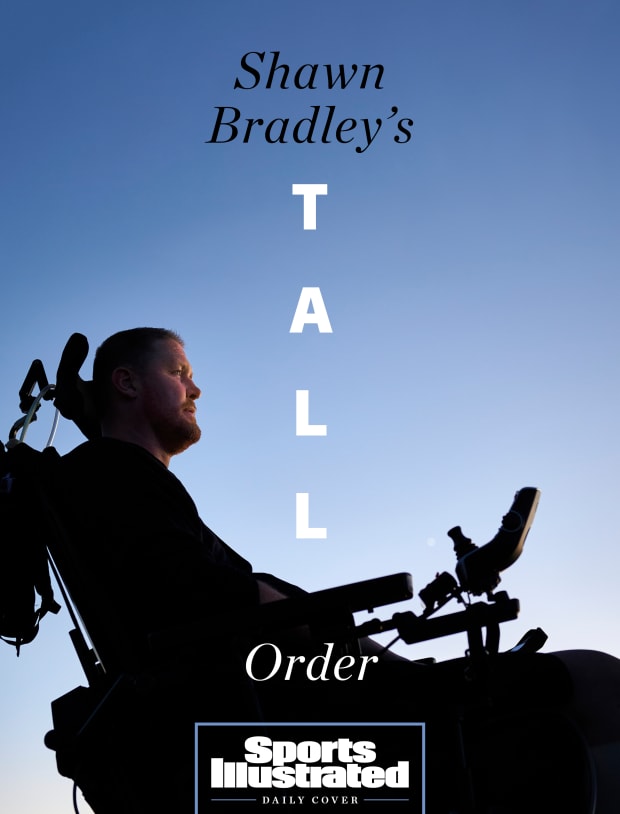
Kohjiro Kinno/Sports Illustrated
Time and distance have separated them, but the warmth between two men who used to drive each other home after games was still evident, even if Finley’s eyes betrayed the shock of looking down upon someone who long towered over him. They talked about their kids and their former teammates—Bradley was stunned to learn that the mercurial Josh Howard was now a college coach at UNT-Dallas—and Carrie insisted upon capturing the moment with a photo. She carefully obscured the catheter bag that hangs from Bradley’s wheelchair, and the friends crammed together to pose . . . until Bradley asked her to wait. He pawed at the controls on his right armrest and, ever so slowly, his chair began to rise. A mechanical whirring underpinned nervous silence as the group watched the third-tallest player in NBA history grow just . . . a bit . . . taller. When Bradley and the 6'7" Finley were finally shoulder to shoulder, Bradley acceded to the pic and smiled.
His desire to loom as tall as his chair would allow is understandable. Bradley’s height has long defined him. It imbued him with confidence. It enabled him, even at 235 pounds, to become a lottery pick out of BYU. It helped him to average 2.5 blocks, ninth-most in NBA history. It pulled every gaze toward him whenever he ducked under a door frame to enter a room.
Now, though, his height is his primary hindrance. Already facing the most trying of circumstances, Bradley will see every task made doubly demanding by his stature. His accident presents a challenge without precedent in modern medical history, and the totality of it all will tax his mental health, as well as that of the people who love him, particularly the relentlessly positive wife onto whose shoulders have fallen extraordinary responsibility.
Before Finley left, Bradley savored a goodbye hug. “It’s hard for me to let them see me like this,” he said afterward, choking back tears. “It’s the challenge of remembering what once was . . . and knowing it’ll never be the same.”
Bradley passed the early afternoon of his last normal day astride a black custom-made Trek Project One bicycle with seven six inscribed on the frame (for his height, not for the 76ers, who drafted him). He had logged thousands of miles on that bike, roughly one and a half times the height of a standard model, as a means of keeping body and mind nimble in retirement. He even willed his way through several 100-mile rides.
Just before he exited a roundabout, a few blocks from his home in St. George, Utah, Bradley says he took note of a Saturn sedan parked on the shoulder of the two-lane street ahead, knowing that he would have to zag left if the driver’s door opened. Hugging the right edge of the right-hand lane, he says he signaled a move farther into the lane as he pedaled up a slight grade, cruising at 12 mph.
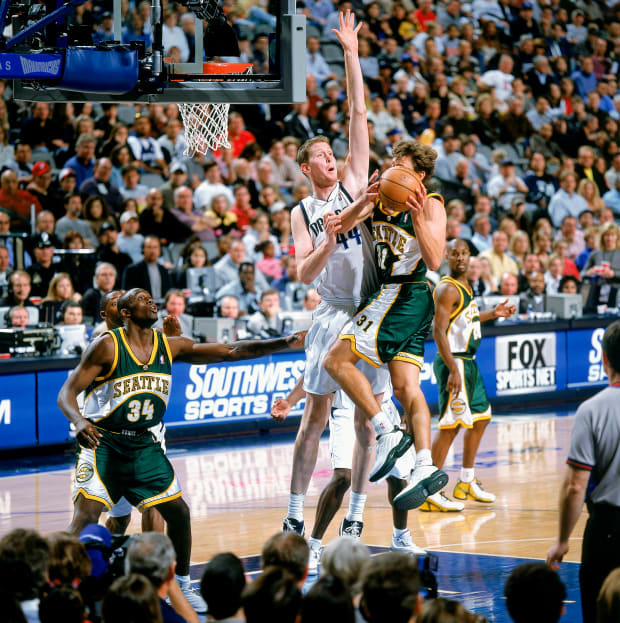
John W. McDonough/Sports Illustrated
In a Dodge minivan just behind him, a young mother was hustling to pick up her child from school. Bradley, who avoids naming the driver, to shield her from public scrutiny, says she bumped him from behind as he drifted left to avoid the Saturn—his Garmin GPS shows that he instantaneously accelerated to 17 mph—which propelled him toward the parked car. The shifter on his right handlebar caught the Saturn’s rear flank and jerked his front wheel sharply to the right, pulling the bike to a sudden stop and sending Bradley’s colossal body skyward.
Bradley tumbled over the trunk and the driver’s side of the Saturn, and he landed headfirst on the asphalt, his helmet cracking under his 300-odd pounds. (Police say the driver continued on but returned to the scene later. Never charged with a crime, she says she gave Bradley enough room when passing him.) Confused but conscious after the spill, splayed on the ground and gazing up at a crystalline sky, Bradley says he went through a mental checklist. He couldn’t move his arms or his legs. He couldn’t sit up. He had no control over his breathing, which soon grew labored. Only his eyes heeded his commands. Am I going to suffocate? he asked himself. Am I going to die slowly?
Just before paramedics arrived, Bradley was finally able to shrug his shoulders, a minuscule motion that he remembers feeling monumental amid the panic. As EMTs loaded him onto a spine board, one worried aloud that Bradley wouldn’t fit into the ambulance, but ultimately they finagled the doors shut.
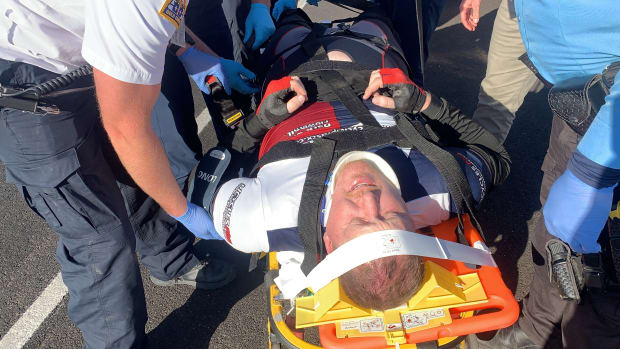
Courtesy of Carrie Cannon Bradley
Carrie collected her husband’s bike and rushed to the hospital, fretting about his fate—and about what might befall her family. Shawn is largely estranged from his first wife and their six children, but he has adopted Carrie’s three kids. And since they married in 2017 he has been a stable force in four lives previously beset by chaos. Carrie says she was mistreated by her last partner, and she worked odd jobs to keep her children enrolled in sports. Given those trials, her friends tended to distrust suitors—until Bradley’s steady, commanding presence won both them and her children over. (Bradley is no stranger to delicate situations; after the NBA, he spent a decade as a vice principal and athletic director at a Utah school for at-risk teens.) When Max, now 14, hid in a tree after his father showed up unexpectedly at a soccer tournament, Shawn was able to reach up and coax him down. Dubbie, 18, once crawled out of his bedroom window, despondent, and sat on the roof. Bradley clambered out to sit and talk with him. Haylie, 20, had long been resentful of men after watching what her mother had endured, so Carrie was stunned to hear her talking to Shawn on the couch for two hours one evening.
Now, though, the man those kids had learned to lean on was being wheeled away into surgery after an MRI revealed that a pair of vertebrae in his neck had shifted, pinching his spinal cord. Waiting outside the operating room, Carrie didn’t know what version of the man she had fallen in love with would emerge—or how much of her family’s precious new stability would survive the crash.
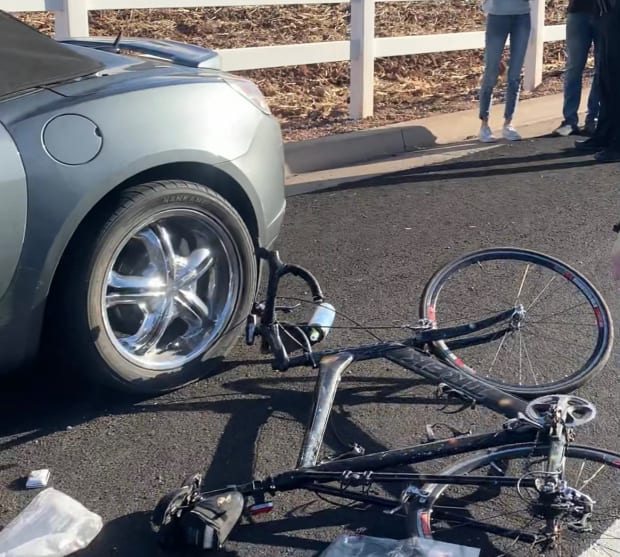
Courtesy of Carrie Cannon Bradley
Bradley spent the next three weeks in the ICU at St. George Regional Hospital, in a sedative-induced fog, with a breathing tube down his throat. At one point he moved an arm and pointed his fingers in Carrie’s direction. No one in that room could decipher what he was trying to say, but in his mind, over and over, he muttered, I love you.
A surgeon had by then inspected Bradley’s spinal cord and fused damaged vertebrae in the base of his neck, diagnosing him as a C6 quadriplegic. Meaning: a loss of sensation and function from the top of his rib cage down, and the expectation that his triceps, and the muscles in his hands and forearms, would have little to no function, though the extent differs from case to case. Typically, people with this diagnosis will maintain control of their shoulders and biceps.
With Bradley’s type of spinal cord injury comes a higher risk for cardiovascular disease, pneumonia, fatal blood clots, gastrointestinal issues, chronic pain and pressure ulcers, from the many hours he’ll spend moored to beds and chairs. Based on this alone, his life expectancy would be roughly three-quarters that of an otherwise healthy man his age. For Bradley, though, many of these concerns are exacerbated by his extreme height, which studies have shown to shorten lifespan and increase risk for cardiovascular issues. “His size adds a bigger complexity,” says Philip Lamoreaux, Bradley’s occupational therapist at St. George. And it is going to “affect his ability to participate in life as he gets older.”
After three weeks in the ICU, Bradley moved to an inpatient neurological rehab wing, where a team of physical and occupational therapists, nurses and dietitians confronted a unique challenge. That group’s leader, Dr. Bryndon Hatch, dug through research and consulted with peers around the country, but he found no road map for managing quadriplegia at such a scale. “Usually, we do our first day of evaluation and then treatment after that,” Hatch says. “For him, it was several days for evaluation, and going back to the drawing board on everything.”
Hatch and his team had to recalibrate their processes—and their equipment. Their patient couldn’t fit in his hospital shower, so he had to be transferred to a separate room to be bathed. Given his sheer girth—he’s now up to 350 pounds; each leg, alone, weighs more than Carrie—the staff had to learn how to transfer him among beds, chairs and exam tables. They reconfigured an ultrasound to account for the depth of his torso and stationed a padded table at the end of his bed, which his feet hung over. They patiently awaited the design and construction of a custom electric wheelchair and in the meantime duct-taped padding and a board to the largest chair they had to create a makeshift headrest.
The most significant improvements for spinal cord patients typically take place in the first six months, and Bradley made strides in that time. Initially, he couldn’t feed himself or sip water or grasp his phone or brush his teeth. Then, late one night, irritable and unmotivated, he demanded McDonald’s. Carrie obliged and dropped the food on his stomach, hoping the lure of warm french fries might motivate him. “How much do you want it?” she asked, challenging her husband as if she were one of his old coaches. Gradually, painfully, Bradley extended his arms toward the fries, wedged a few between his hands and took his first unassisted bite in weeks. Soon, a fork was fashioned that he could thread between his fingers, and he slowly regained a vital measure of independence.
Typically, the treatment of a spinal cord patient like Bradley will cost between $300,000 and $1 million in the first year, and roughly $5 million over a lifetime. He is fortunate to have the means to cover those staggering costs, having earned $69.5 million in his career. And his NBA health insurance policy allowed him four months of inpatient treatment, roughly double the usual stay.
In those long weeks he missed riding his motorcycle, taking his boat out on Sand Hollow Reservoir, wrestling with his kids, wrapping his arms around Carrie from behind and giving her a gentle squeeze. And as the days wore on, measured by the changing holiday decorations at the hospital, the sum of these modest losses grew profound. “All those little things mean the world to me,” Bradley says.
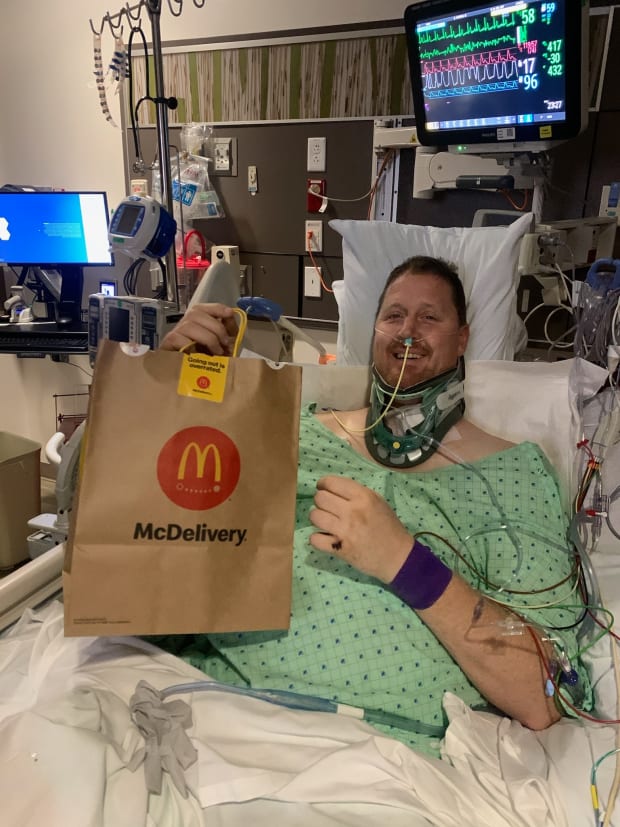
Courtesy of Carrie Cannon Bradley
When Lamoreaux bathed him in the hospital, the two discussed how Bradley’s relationship with Carrie was bound to change, how he would have to grow comfortable with caregivers undertaking intimate tasks, how his interactions with every person, every institution, every object would be forever altered. “His body and his skills have been his identity,” Lamoreaux says. “And he’s constantly faced with that part of his identity being gone. Navigating through that was really difficult for him.”
A visit last spring from two old friends helped him reconnect, however briefly, with his old self. In April, after Bradley and Carrie worked with the Mavs to put out a statement announcing the incident to the world, Nowitzki (now a special adviser for Dallas) and team owner Mark Cuban flew to Bradley’s home in Utah, and Shawn wedged into a minivan to travel home, where he met with his old friends. Dirk and Dubbie, who plays junior college soccer, dribbled a ball on the slate tile in Bradley’s living room, and eventually the three old Mavs spent an hour reminiscing. Even after so much time apart, Bradley says he felt their genuine concern and affection.
Once they left, though, Bradley confronted unfamiliar emotions that plague him to this day—the same feelings that would surface in the luxury box visit with Finley. He had spent months, along with his family, adjusting to his new identity, but he had not yet watched anyone else close to him digest it in real time. Pandemic-related lockdowns at the hospital had enabled the Bradleys to keep Shawn’s condition a secret, buying them time to cope with their new circumstances before confronting the inevitable deluge of well-wishers and media.
Even at home, though, the reintroduction to Nowitzki and Cuban left him vulnerable, so an hour of smiles with friends begat a day of tears in solitude. “People that I’m very close with, the first time they see me, it’s emotional,” Bradley says. “It’s extremely draining.”
The day after the reunion with Finley in Dallas, at a rehab center 23 miles from the arena, two physical therapists strapped a thick band around Bradley’s waist and, in an intricate dance honed over time, wrestled him out of his wheelchair and onto a padded table. They guided him through a series of exercises that appear mundane but are, in fact, impossibly demanding. From a seated position, bracing his own weight with one arm, Bradley lowered himself onto his side and then pushed himself back up to a seated position. Bellows and grunts echoed from his cavernous chest as Carrie and the therapists shouted encouragement. He successfully pushed his body up from the right side, but he struggled repeating the exercise on the left, inhibited by a torn rotator cuff. “All hands on deck,” says Matt Kawash, one of several therapists now charged with learning how to manipulate a man so massive without dropping or injuring him.
The Bradleys ended up at this outpatient rehabilitation arm of Baylor Scott & White Health, just north of Dallas, after Carrie called facilities across the country, searching for one that could both accommodate her husband’s size and provide the sort of athlete-focused training to which he responds. While most patients come in twice a week, Bradley was a Monday-to-Friday client this fall. And the sessions, he says, left him yearning for three-a-days under his old coach with the Nets, John Calipari, whose grueling practices often left the center hobbled. Now, when his body tires, the constant tingling in his arms and his torso—akin to coming inside after playing in the snow—morphs into painful spasms. A half dozen times per day, Bradley stops himself mid-sentence to grit his teeth and wince.
He and his Dallas team set a clear goal: for Bradley to be able to transition from a chair to his bed and back, without assistance, an essential move in reclaiming life-altering independence. “That’s something we all think is possible,” Bradley says. “We’re not there yet—but we’re getting there.”
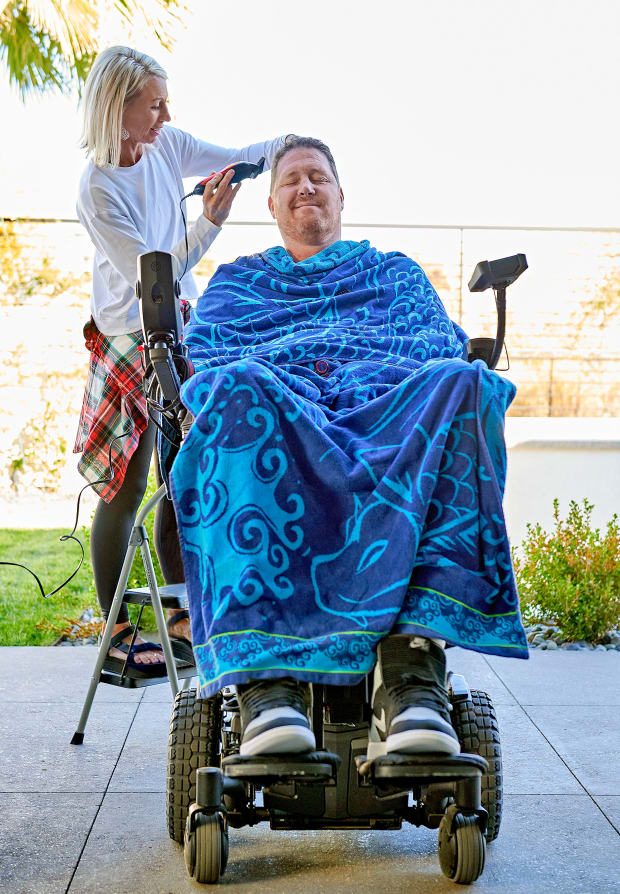
Kohjiro Kinno/Sports Illustrated
As he strains to improve himself, Bradley is determined to find a means of helping others. Educating the masses about bike safety is a priority: More than 800 Americans die in bike crashes involving motor vehicles every year. (Last May, a fellow 7-footer and Utahan, 64-year-old Mark Eaton, who played 11 seasons with the Jazz, died after a bike crash, but no vehicle was involved in his accident.) What’s more, roughly 300,000 Americans are currently living with severe spinal cord injuries.
Bradley understands that the strains on mental health—for patients and for loved ones turned caregivers—can be just as detrimental as physical impairments. To anyone facing a battle like his, he wants to bring comfort and stability, just as he once did for his new family. One neighbor in Utah recalls Bradley asking aloud, “Why didn’t I die?” and says: “I feel like he’s determined to find out what that reason is.”
Home since November, Bradley’s days now begin, typically, in the middle of the night. Every three hours an alarm rouses him, and he shifts his legs using straps tied around his knees, rolling from one side to the other to prevent bedsores. Around 9 a.m. a caregiver readies him for the day, cleaning up any messes he may have made overnight, ensuring that he has a bowel movement, dressing him in a disposable brief and basketball shorts by rocking him back and forth a dozen times to shimmy the garments up. Then, using a contraption that resembles a small crane, with a fabric sling on the end, the aide moves Bradley from his bed into his wheelchair, another 15-minute ordeal. They will repeat these same steps, in reverse, 12 hours later.
Bradley uses an $8,000 custom-made shower chair that fits in his downstairs bathroom, but the process is so onerous for Carrie that she bathes him only twice per week. Occasionally she has had to help with bowel-movement cleanup when her husband has an accident and an aide can’t reach him. In such a young marriage, these are boundaries that Bradley wishes Carrie never had to cross, but the line between spouse and caretaker has already blurred irrevocably. They visit a therapist together, and separately, trying to navigate scenarios that neither of them could have fathomed when they exchanged vows. “I didn’t ask her to do this,” Bradley says. “This isn’t what ‘in sickness and in health’ typically means.”
To cope with old traumas and fresh ones, Carrie remains in perpetual motion—tending to her husband, scheduling appointments, keeping pace with her kids. When Shawn was in the hospital she would often bring in pastries to lift up the staff, then return home and collapse in her upstairs closet, hoping the clothes muffled her sobs. “It’s not just the person that’s involved in the accident,” Carrie says. “It’s a domino effect. Our family has been forever changed.”
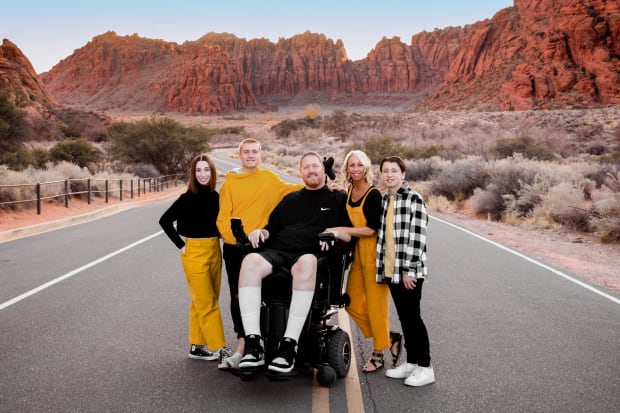
Becky Hansen/Smile Creations Portrait Studio
The Bradleys, still, probe constantly for normalcy. After Shawn left the hospital in May they tried a date night, but it required that Carrie scout a movie theater to determine whether the venue could accommodate Bradley’s mammoth wheelchair—a rig that weighs nearly 500 pounds, took three months to engineer and, he says, “costs more than most cars.” Carrie had to tend to Shawn’s popcorn and soda throughout the film, then load him into the family’s new $120,000 cargo van, which lists violently to one side as its hydraulic lift raises him up. Even date night exhausted her. “I love him, and he was so happy,” she says, “so I never wanted to tell him.”
Bradley is awed by his wife and all that she has done, not just to keep him alive but to make life worth living. For years, his presence buoyed their family. Now, unquestionably, he is their preeminent concern—and “I don’t know how I can ease the burden of me,” he says. When that conundrum weighs most heavily upon him, he can’t avoid considering one way to solve it. “Maybe it’d be better if this was just all over,” he says. “Yes, those thoughts creep in—and they’re real. I can’t ever imagine myself acting on those thoughts, but I definitely have them.”
The Bradleys built their dream home in St. George a little over two years ago, and while it was designed for a 7'6" former NBA center—expansive door frames, super-tall vanities, chest-high doorknobs—it was not designed for a 7'6" former NBA center in an electric wheelchair. Shawn can’t access the gym or the home theater in the basement. To avoid crushing the tracks that keep wall-sized sliding doors in place, he must take the long way around the side of the house to reach his backyard, with the pool in which he can’t swim. Because he needs room to shift positions at night, Carrie sleeps upstairs in the master bedroom while he’s relegated to a first-floor guest room. He’s confined to just a fraction of a sprawling three-story home.
So the family has begun planning for an accessible version of the same house, this one in suburban Dallas, with elite care and rehab facilities nearby. Instead of a basement, it will have an outbuilding, and it will all sit on a wide tract of land, with smooth walking paths so Shawn can roam the grounds. With his circulation poor and his muscle mass dwindling, he often grows cold, so he treasures time spent outside with the sun on his face.
But that’s all a way off. In Utah, a few days before Thanksgiving, holiday music drifted down from ceiling speakers in the Bradleys’ current lofty living room. Shawn had just returned from his long rehab stint in Dallas; this marked the first time that he, Carrie and the kids shared quiet time alone at home in months. A 12-foot Christmas tree, bare and awaiting ornaments, stood along the back wall. A year earlier, as they finished trimming, Shawn had scooped Carrie up on his shoulders so that she could crown their tree with a star. This time, humming along to Leonard Cohen’s “Hallelujah,” he sat off to the side, allowing Carrie and the kids room to do their work.
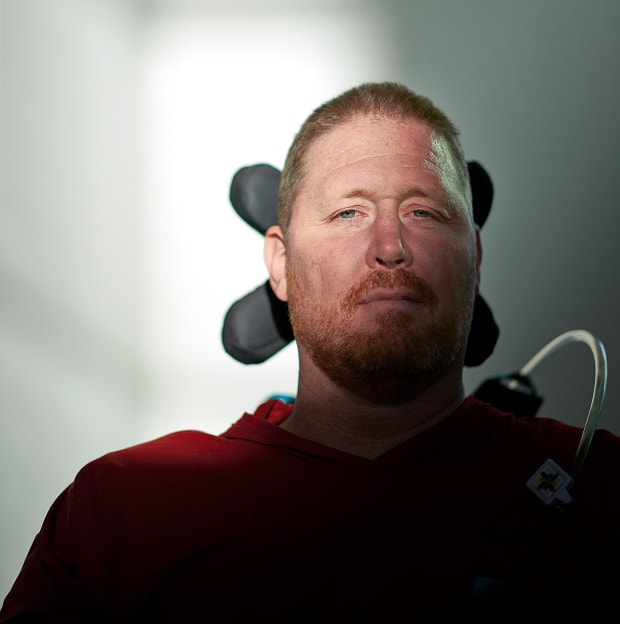
Kohjiro Kinno/Sports Illustrated
Dubbie stood on a ladder. Carrie on a stepstool. Armed with soft red-and-white snowflake ornaments, each strained to reach parts of the tree that Shawn once accessed with ease. Finally, Bradley asked for a handful of the ornaments, wheeled closer to the tree and, one by one, slid them between his spindly, rigid fingers and jerked his arm forward, flinging the flakes awkwardly upward.
His first few attempts caromed off the branches and tumbled to the floor, but Carrie and the kids laughed along and encouraged him to toss a few more.
So, eyes trained on the top of the tree, Shawn Bradley kept trying.







